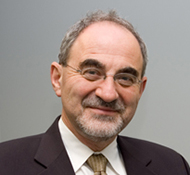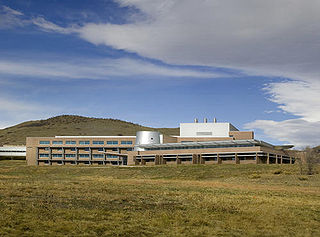Related Research Articles

Eli Yablonovitch is an American physicist and engineer who, along with Sajeev John, founded the field of photonic crystals in 1987. He and his team were the first to create a 3-dimensional structure that exhibited a full photonic bandgap, which has been named Yablonovite. In addition to pioneering photonic crystals, he was the first to recognize that a strained quantum-well laser has a significantly reduced threshold current compared to its unstrained counterpart. This is now employed in the majority of semiconductor lasers fabricated throughout the world. His seminal paper reporting inhibited spontaneous emission in photonic crystals is among the most highly cited papers in physics and engineering.

The National Renewable Energy Laboratory (NREL) in the US specializes in the research and development of renewable energy, energy efficiency, energy systems integration, and sustainable transportation. NREL is a federally funded research and development center sponsored by the Department of Energy and operated by the Alliance for Sustainable Energy, a joint venture between MRIGlobal and Battelle. Located in Golden, Colorado, NREL is home to the National Center for Photovoltaics, the National Bioenergy Center, and the National Wind Technology Center.

Martin Andrew Green is an Australian engineer and professor at the University of New South Wales who works on solar energy. He was awarded the 2021 Japan Prize for his achievements in the "Development of High-Efficiency Silicon Photovoltaic Devices". He is editor-in-chief of the academic journal Progress in Photovoltaics.
Allen M. Barnett was a research professor of electrical engineering at the University of Delaware. He was the principal investigator of the DARPA-funded Consortium for Very High Efficiency Solar cells. Barnett was the founder and CEO of solar-cell producer Astropower, Inc. He was also a Professor of Advanced Photovoltaics at the University of New South Wales (UNSW) School of Photovoltaic and Renewable Energy Engineering (SPREE) in Sydney Australia.

According to data from the US Energy Information Administration, renewable energy accounted for about 13.1% of total primary energy consumption and about 21.5% of total utility-scale electricity generation in the United States in 2022.

Michael Grätzel is a professor at the École Polytechnique Fédérale de Lausanne where he directs the Laboratory of Photonics and Interfaces. He pioneered research on energy and electron transfer reactions in mesoscopic-materials and their optoelectronic applications. He co-invented with Brian O'Regan the Grätzel cell in 1988.

Alex Zunger is a theoretical physicist, research professor, at the University of Colorado Boulder. He has authored more than 150 papers in Physical Review Letters and Physical Reviews B Rapid Communication, has an h-index over 150, number of citations over 113,000. He co-authored one of the top-five most cited papers ever to be published in the Physical Review family in its over 100 years' history.
Arthur J. Nozik is a researcher at the National Renewable Energy Lab (NREL). He is also a professor at the University of Colorado, which is located in Boulder. He researches semiconductor quantum dots at the National Renewable Energy Laboratory, and is a chemistry professor at the University of Colorado. He also does research for the advancement of solar energy, for which he won the Intergovernmental Renewable Energy Organization (IREO) Award for Science and Technology in 2009.
George W. Huber is an American chemical engineer. He is the Richard L. Antoine Professor of Chemical Engineering at the University of Wisconsin- Madison. His research focus is on developing new catalytic processes for the production of renewable liquid fuels and chemicals.

Amit Goyal is a SUNY Distinguished Professor and a SUNY Empire Innovation Professor at SUNY-Buffalo. He leads the Laboratory for Heteroepitaxial Growth of Functional Materials & Devices. He is also Director of the New York State Center of Excellence in Plastics Recycling Research & Innovation, an externally funded center with initial funding of $4.5M for three years at SUNY-Buffalo. He is the founding director of the multidisciplinary and transdisciplinary RENEW Institute at SUNY-Buffalo in Buffalo, New York and served as director from 2015-2021. RENEW is an internally funded research institute at SUNY-Buffalo. For his contributions to UB, in 2019, he was awarded the University at Buffalo or SUNY-Buffalo President's Medal, which recognizes “outstanding scholarly or artistic achievements, humanitarian acts, contributions of time or treasure, exemplary leadership or any other major contribution to the development of the University at Buffalo and the quality of life in the UB community.” This is one of the highest recognitions given at the university.
Amonix, Inc. is a solar power system developer based in Seal Beach, California. The company manufactures concentrator photovoltaic (CPV) products designed for installation in sunny and dry climates. CPV products convert sunlight into electrical energy in the same way that conventional solar photovoltaic technology does, except that they use optics to focus the solar radiation before the light is absorbed by solar cells. According to a comparative study of energy production of solar technologies, CPV systems require no water for energy production and produce more energy per megawatt (MW) installed than traditional PV systems. Amonix has nearly 70 megawatts of CPV solar power systems deployed globally, including Southwestern U.S. and Spain. In May 2012, the Alamosa Solar Generating project, owned and operated by Cogentrix Energy, began commercial operation. This is the largest CPV power plant in the world and is expected to produce enough clean renewable energy per year to power more than 6,500 homes and will avoid the emissions of over 43,000 metric tons of carbon dioxide per year. The Alamosa Solar Generating Project is supported by a power purchase agreement (PPA), which is a long-term agreement to sell the power it will generate. Under the project's PPA, the Public Service Company of Colorado will buy the power generated by the solar facility for the next 20 years. In July 2012, Amonix set the world record for photovoltaic module efficiency at 33.5% under nominal operating conditions, verified by the National Renewable Energy Laboratory. In April 2013, Amonix broke the record set in July 2012, demonstrating photovoltaic module efficiency at 34.9% under normal concentrator standard operating conditions, also verified by the National Renewable Energy Laboratory. In August 2013, Amonix announced it had achieved a 35.9% photovoltaic module efficiency rating under concentrator standard test conditions (CSTC) as calculated by NREL. In June, 2014, the assets of Amonix were acquired by Arzon Solar, LLC for the purpose of continued development of CPV technology and products.
Yang Yang is a Taiwanese-American materials scientist. He is a Professor of Materials Science and Engineering, and Professor of Bioengineering at the University of California, Los Angeles, where he holds the Carol and Lawrence E. Tannas Jr. Endowed Chair in Engineering. Yang is known for his contributions to polymer organic solar cells and lead-halide perovskite solar cells. He was named as one of the "World’s Most Influential Scientific Minds" by Thomson Reuters in 2016. Yang is a fellow of the American Association for the Advancement of Science, American Physical Society, Materials Research Society, Royal Society of Chemistry, and Society of Photo-Optical Instrumentation Engineers.

Henrik Lund is a Danish engineer and professor at Aalborg University.
Umesh K. Mishra is a professor in the Electrical & Computer Engineering Department at the University of California, Santa Barbara (1990–Present). In 2023, he was appointed dean of the UC Santa Barbara College of Engineering. He is the CTO, co-founder and board member of Transphorm, founded in 2007 and the first company to deliver gallium nitride (GaN) transistor products for high efficiency power conversion technologies. Prior to Transphorm, he co-founded Nitres Inc. in 1996, which was the first company to develop GaN LEDs and transistors.
Brian Vad Mathiesen is a Danish engineer and professor at Aalborg University. He was listed among ISI Highly Cited researchers in 2015 and 2016, making him one of the leading engineers in the world.
Onkar Nath Srivastava was an Indian material physicist, an Emeritus professor of Banaras Hindu University and the vice president for India and South Asia of the International Association for Hydrogen Energy, who was known for his contributions to the disciplines of nanotechnology and hydrogen energy. He was the author of two books and over 440 scientific papers and a recipient of several honors including Shanti Swarup Bhatnagar Prize, the highest Indian award in the science and technology categories. The Government of India awarded him the fourth highest civilian honour of the Padma Shri, in 2016, for his contributions to science and engineering.
Charles E. Wyman, is a Ford Motor Company Chair and a Distinguished Professor & Endowed Chair in Chemical & Environmental Engineering at University of California, Riverside. Wyman was also the Paul E. and Joan H. Queneau Distinguished Professor in Environmental Engineering Design at the Thayer School of Engineering at Dartmouth College, Prior to joining UC Riverside. He is the co-founder and former Chief Development Officer and Chair of the Scientific Advisory Board of Mascoma Corporation. He is one of the researchers responsible for the development of the Bioenergy, Biomass & Biofuel. He is an authoritative figure in the broad area of ethanol. He has made significant seminal contributions in the specific areas of pretreatment, enzymatic hydrolysis, and dehydration of cellulosic biomass to reactive intermediates for biological or catalytic conversion into fuels and chemicals. Wyman has over 200 journal papers, 25 books chapters, and has given numerous national and international talks, 30 technical reports and about more than 20 patents.

Vinay Gupta is an Indian materials scientist and a former senior scientist at the Physics of Energy Harvesting department of the National Physical Laboratory of India. Known for his studies on organic solar cells, carbon nanotubes arrays and Förster resonance energy transfer, Gupta is a former Alexander von Humboldt Fellow. The Council of Scientific and Industrial Research, the apex agency of the Government of India for scientific research, awarded him the Shanti Swarup Bhatnagar Prize for Science and Technology, one of the highest Indian science awards, for his contributions to physical sciences in 2017.
Sarah R. Kurtz is an American materials scientist known for her research on solar energy and photovoltaics, including the application of multi-junction solar cells in robotic spacecraft. Formerly a research fellow at the National Center for Photovoltaics and principal scientist at the National Renewable Energy Laboratory, she is a professor of materials science and engineering at the University of California, Merced.
References
- ↑ "NREL's Keith Emery Awarded Prestigious Cherry Award".
- ↑ "Highly Cited Researchers: Home". Thomson Reuters.